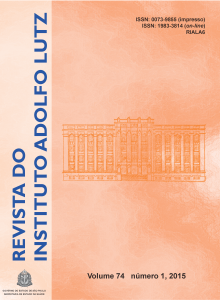Abstract
This study evaluated the implementation of Good Handling Practices in an Institutional Inclusion Unit in Santa Maria-RS through a program of tax incentives and training, and to assess the included investment. In the first month, a checklist was applied for assessing the adequacy of the Good Handling Practice. An action plan was developed to adjust the nonconformities, to survey the costs and to submit the project for approval. After being approved, a training was done and an eight-month period was stipulated for adjusting the nonconformities. In the last month, the checklist was applied again. In the first checklist application, the unit showed 38 % of adequacy; and after performing some investments, it came to be 93 %.In this first application, low percentage of adequacy was detected in the following issues Integrated Pest Control, Documentation and Registration, and Responsibility. After setting some investments, these items and other issues as Water Supply, Waste Management, Raw Material, Ingredients, Packaging, Storage and Transportation of Prepared-Food showed 100 % of adequacy, and the item with the highest investment was Buildings, Facilities, Furniture and Utensils. At the disposal of the investments and training, an increase in the percentage of adequacy concerning the Good Handling Practices was achieved.References
1. Ministério do Desenvolvimento Social. Serviço de Acolhimento Institucional. 2012. Disponível em: [http://www.mds.gov.br/falemds/perguntas-frequentes/assistencia-social/pse-protecao-social-especial/servicos-de-alta-complexidade/servico-de-acolhimento-institucional].
2. Ministério Público do Distrito Federal e Territórios. Abrigo para crianças e adolescentes. Manual de Orientação. 2012. Disponível em: [http://www.mp.go.gov.br/portalweb/hp/8/docs/manual_de_orientacoes_abrigos_para_criancas_e_adolescentes_mpdf.pdf].
3. Stangarlin L, Hecktheuer LH, Serafim AL, Saccol ALF. Instrumentos e Apoio para Implantação das Boas Práticas em Serviços de Nutrição e Dietética Hospitalar. 1ª ed. Rio de Janeiro: Rubio; 2013.
4. Silva Jr EA. Manual de Controle Higiênico-sanitário em Serviços de Alimentação. 6ª ed. São Paulo: Varela; 2012.
5. Unusan N. Consumer food safety knowledge and practices in the home in Turkey. Food Control. 2007; 18(1): 45–51. doi:10.1016/j.foodcont.2005.08.006
6. Tondo EC, Bartz, S. Microbiologia e Sistemas de Gestão da Segurança dos Alimentos. 1ª ed. Porto Alegre: Sulina; 2011.
7. Rio Grande do Sul. Secretaria da Saúde. Portaria nº 78 de janeiro de 2009. Aprova a Lista de Verificação em Boas Práticas para Serviços de Alimentação, aprova Normas para cursos de Capacitação em Boas Práticas para Serviços de Alimentação e dá outras providências. Diário Oficial do Estado do Rio Grande do Sul, Porto Alegre, RS, 30 jan. 2009.
8. Crespo AA. Estatística fácil. 18º ed. São Paulo: Saraiva; 2002.
9. Proença RPC, Sousa AA, Veiros MB, Hering B. Qualidade nutricional e sensorial na produção de refeições. Florianópolis: Ed. UFSC; 2005.
10. Marongwe LS Kwazira K, Jenrich M, Thierfelder C, Kassam A. An African success: the case of conservation agriculture in Zimbabwe. Int J Agricult Sustain. 2011; 9 (1):153-61. http://dx.doi.org/10.3763/ijas.2010.0556
11. Garayoa R, Vitas AI, Díez-Leturia M, García-Jalón I. Food safety and the contract catering companies: Food handlers, facilities and HACCP evaluation. Food Control. 2011; 22(12): 2006-12. doi: 10.1016/j.foodcont.2011.05.021
12. Rodrigues KL, Silva JA, Aleixo JAG. Effect of the implementation of the Hazard Analysis Critical Control Point (HACCP) prerequisite program in an institutional foodservice unit in Southern Brazil. Ciênc Tecnol Aliment. 2012; 32(1): 196-200. http://dx.doi.org/10.1590/S0101-20612012005000028
13. González-Muñoz Y, Palomino-Camargo CE. Acciones para la gestión de la calidad sanitaria e inocuidad de los alimentos en un restaurante con servicio bufet. Rev Gerenc Polit Salud. 2012; 11(22): 123-40.
14. Sung-Hee P, Tong-Kyung K, Hye-Ja C. Evaluation of the food safety training for food handlers in restaurant operations. Nutr Res Pract. 2010; 4(1): 58-68. doi: 10.4162/nrp.2010.4.1.58
15. Saccol ALF, Stangarlin L, Hecktheuer LH. Instrumentos de apoio para a implantação das Boas Práticas em empresas alimentícias. 1ª ed. Rio de Janeiro: Rubio; 2012.

This work is licensed under a Creative Commons Attribution 4.0 International License.
Copyright (c) 2015 Instituto Adolfo Lutz Journal
